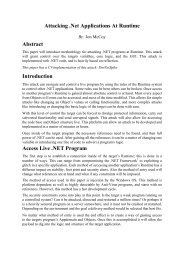You also want an ePaper? Increase the reach of your titles
YUMPU automatically turns print PDFs into web optimized ePapers that Google loves.
Open in 30 Seconds<br />
Cracking One of the<br />
Most Secure Locks in America<br />
Marc Weber Tobias<br />
Matt Fiddler
LOCKS, LIES, and “HIGH”<br />
INSECURITY<br />
• Dominant high security lock maker<br />
• 40 year history of security<br />
• Many expert attempts to crack with limited<br />
success, complicated tools<br />
• Misstatements and disinformation<br />
• 18 month research project results:<br />
A Total compromise of security
MEDECO HIGH SECURITY:<br />
• UL, BHMA / ANSI, VdS Certified<br />
• High level of protection against attack<br />
• Picking: 10-15 minute resistance<br />
• No bumping<br />
• Forced Entry: 5 minutes, minimum<br />
• Key control<br />
– Protect restricted and proprietary keyways<br />
– Stop duplication, replication, simulation of keys
HIGH SECURITY LOCKS:<br />
• Protect Critical Infrastructure, high<br />
value targets<br />
• Stringent security requirements<br />
• High security Standards<br />
• Threat level is higher<br />
• Protect against Forced, Covert entry<br />
• Protect keys from compromise
MEDECO HISTORY<br />
• Dominant high security lock maker in U.S.<br />
• Owns 70+ Percent of U.S. high security<br />
market for commercial and government<br />
• Major government contracts<br />
• In UK, France, Europe, South America<br />
• Relied upon for highest security everywhere<br />
• Considered almost invincible by experts
WHY THE MEDECO CASE<br />
STUDY IS IMPORTANT<br />
• Insight into design of high security locks<br />
• Patents are no assurance of security<br />
• Appearance of security v. Real World<br />
• Undue reliance on Standards<br />
• Manufacturer knowledge and<br />
Representations<br />
• Methodology of attack<br />
• More secure lock designs
CONVENTIONAL v.<br />
HIGH SECURITY LOCKS<br />
• CONVENTIONAL CYLINDERS<br />
– Easy to pick and bump open<br />
– No key control<br />
– Limited forced entry resistance<br />
• HIGH SECURITY CYLINDERS<br />
– UL and BHMA/ANSI Standards<br />
– Higher quality and tolerances<br />
– Resistance to Forced and Covert Entry<br />
– Key control
ATTACK METHODOLOGY<br />
• Assume and believe nothing<br />
• Ignore the experts<br />
• Think “out of the box”<br />
• Consider prior methods of attack<br />
• Always believe there is a vulnerability<br />
• WORK THE PROBLEM<br />
– Consider all aspects and design parameters<br />
– Do not exclude any solution
HIGH SECURITY LOCKS:<br />
Critical Design Issues<br />
• Multiple security layers<br />
• More than one point of failure<br />
• Each security layer is independent<br />
• Security layers operate in parallel<br />
• Difficult to derive intelligence about a<br />
layer
HIGH SECURITY:<br />
Three Critical Design Factors<br />
• Resistance against forced entry<br />
• Resistance against covert and<br />
surreptitious entry<br />
• Key control and “key security”<br />
Vulnerabilities exist for each requirement
BYPASS AND REVERSE<br />
ENGINEERING<br />
• Weakest link in lock to bypass (Medeco)<br />
• What locks the lock?<br />
• What locking elements lock and in what<br />
order. Is there a primary element to bypass?<br />
• Result if one layer fails: Can others be<br />
compromised?<br />
• What intelligence needed to open the lock?<br />
• Can Intelligence be simulated?
SYSTEM BYPASS<br />
• How strong is the sidebar(s) against<br />
forced attack<br />
• Is the sidebar the only locking system?<br />
• What if defeat one of two sidebars or<br />
security layers?<br />
• Bitting design: spring biased?<br />
• Ability to manipulate each pin or slider<br />
to set its code?
SECONDARY SECURITY<br />
LAYERS<br />
• Telescoping pins<br />
• Sliders and wafers<br />
• Sliders to set sidebars: Medeco<br />
• Pseudo-sidebars = virtual keyways<br />
• Sidebars<br />
– Most popular<br />
– Originated in America with GM locks<br />
– Many locking techniques
LAYERS OF SECURITY<br />
AND BYPASS CAPABILITY<br />
• How many<br />
• Ability to exploit design feature?<br />
• Integrated<br />
• Separate<br />
– Primus = 2 levels, independent, complex locking<br />
of secondary finger pins<br />
– Assa = 2 levels, independent, simple locking, one<br />
level
EXPLOITING<br />
FEATURES<br />
• Codes: design, progression<br />
• Key bitting design<br />
• Tolerances<br />
• Keying rules<br />
– Medeco master and non-master key systems<br />
• Interaction of critical components and locking<br />
systems<br />
• Keyway and plug design
EXPLOITING<br />
TOLERANCES<br />
• Sidebar locking: Medeco 10 v. 20 degree<br />
• Relation to codes<br />
• Simulation of codes: Medeco<br />
• Reverse engineer code progression of<br />
system from one or more keys?<br />
– Master key conventional v. positional system<br />
– Difficulty = replication of keys<br />
– Medeco v. MCS as example
ATTACKS:<br />
Two Primary Rules<br />
• “The Key never unlocks the lock”<br />
– Mechanical bypass<br />
• Alfred C. Hobbs: “If you can feel one<br />
component against the other, you can<br />
derive information and open the lock.”
METHODS OF ATTACK:<br />
High Security Locks<br />
• Picking and manipulation of components<br />
• Impressioning<br />
• Bumping<br />
• Vibration and shock<br />
• Shim wire decoding (Bluzmanis and Falle)<br />
• Borescope and Otoscope decoding<br />
• Direct or indirect measurement of critical<br />
locking components
ADDITIONAL METHODS OF<br />
ATTACK<br />
• Split key, use sidebar portion to set<br />
code<br />
• Simulate sidebar code<br />
• Use of key to probe depths and<br />
extrapolate<br />
• Rights amplification of key
KEY CONTROL<br />
• High security requirement
KEY CONTROL and “KEY<br />
• Duplicate<br />
• Replicate<br />
• Simulate<br />
SECURITY”<br />
“Key control” and “Key Security” may not<br />
be synonymous!
KEY SECURITY: A Concept<br />
• Key control = physical control of keys<br />
• Prevent manufacture and access to blanks<br />
• Control generation of keys by code<br />
• Patent protection<br />
• Key security = compromise of keys<br />
– Duplication<br />
– Replication<br />
– Simulation
KEYS: CRITICAL ELEMENTS<br />
• Length = number of pins/sliders/disks<br />
• Height of blade = depth increments = differs<br />
• Thickness of blade = keyway design<br />
• Paracentric design<br />
• Keyway modification to accommodate other<br />
security elements<br />
– Finger pins<br />
– Sliders
KEY CONTROL:<br />
Critical issues<br />
• Simulation of code or key components<br />
• Security of locks = key control and key<br />
security<br />
– All bypass techniques simulate actions of<br />
key<br />
– Easiest way to open a lock is with the key
KEY CONTROL and “KEY<br />
SECURITY” ISSUES<br />
• Most keys are passive: align = open<br />
• Simulate components of key<br />
• Replicate critical components<br />
• Duplicate critical components<br />
• Require interactive element for security<br />
– MUL-T-LOCK element<br />
– BiLock-NG, Everest Check Pins<br />
– MCS magnets
KEY CONTROL:<br />
Design Issues<br />
• Bitting design<br />
• Bitting and sidebar issues and conflicts and<br />
limitations in differs<br />
• Ability to decode one or more keys to break<br />
system<br />
• Consider critical elements of the key: require<br />
to insure cannot be replicated<br />
• Hybrid attacks using keys<br />
– Medeco mortise cylinder example
DUPLICATION AND<br />
REPLICATION OF KEYS<br />
•Key machine<br />
• Milling machine: Easy Entrie<br />
• Clay and Silicone casting<br />
• Key simulation: Medeco<br />
• Rights amplification<br />
• Alter similar keys
COVERT and FORCED<br />
ENTRY RESISTANCE<br />
• High security requirement
STANDARDS<br />
REQUIREMENTS<br />
• UL and BHMA/ANSI STANDARDS<br />
• TIME is critical factor<br />
– Ten or fifteen minutes<br />
– Depends on security rating<br />
• Type of tools that can be used<br />
• Must resist picking and manipulation<br />
• Standards do not contemplate or<br />
incorporate more sophisticated methods
CONVENTIONAL PICKING
TOBIAS DECODER:<br />
“Crackpot@security.org”
SOPHISTICATED<br />
DECODERS<br />
• John Falle: Wire Shim Decoder
DECODE PIN ANGLES
FORCED ENTRY<br />
RESISTANCE
FORCED ENTRY ATTACKS:<br />
Deficiencies in standards<br />
• Many types of attacks defined<br />
• Mechanical Bypass - Not Contemplated<br />
• Must examine weakest links<br />
• Do not cover “hybrid attacks”<br />
– Medeco deadbolt attacks<br />
– Medeco mortise attack
SIDEBAR:<br />
Bypass and Circumvention<br />
• Direct Access<br />
– Decoding attacks<br />
– Manipulation<br />
– Simulate the sidebar code (Medeco)<br />
– Use of a key (Primus and Assa)<br />
• Indirect access<br />
– Medeco borescope and otoscope decode<br />
issues
SIDEBAR ATTACK:<br />
Physical Strength<br />
• Independent protection<br />
• Integrated with pin tumblers or other<br />
critical locking components<br />
• Plug Compression<br />
• Defeat of sidebar as one security layer:<br />
result and failures<br />
• Anti-drill protection
FORCED ENTRY ATTACKS<br />
• Direct compromise of critical components<br />
– Medeco deadbolt 1 and 2 manipulate tailpiece<br />
• Hybrid attack: two different modes<br />
– Medeco reverse picking<br />
• Defeat of one security layer: result<br />
– Medeco Mortise and rim cylinders, defeat shear<br />
line
MEDECO HIGH SECURITY:<br />
Lessons to be learned<br />
• What constitutes security<br />
• Lessons for design engineers<br />
• Appearance v. reality
MEDECO CASE HISTORY<br />
• Exploited vulnerabilities<br />
• Reverse engineer sidebar codes<br />
• Analyze what constitutes security<br />
• Analyze critical tolerances<br />
• Analyze key control issues<br />
• Analyze design enhancements for new<br />
generations of locks: Biaxial and m3<br />
and Bilevel
MEDECO MISTAKES<br />
• Failed to listen<br />
• Embedded design problems from beginning<br />
• Compounded problems with new designs<br />
with two new generations: Biaxial and m3<br />
• Failed to “connect the dots”<br />
• Failure of imagination<br />
• Lack of understanding of bypass techniques
DESIGN =<br />
VULNERABILITIES<br />
• Basic design: sidebar legs + gates<br />
– How they work: leg + gate interface<br />
– Tolerance of gates<br />
• Biaxial code designation<br />
• Biaxial pin design: <strong>aft</strong> position decoding<br />
• M3 slider: geometry<br />
• M3 keyway design<br />
• Deadbolt design
MEDECO DESIGN:<br />
Exploit design vulnerabilities<br />
• EXPLOIT BEST DESIGN FEATURES<br />
• Sidebar leg – true gate channel<br />
• Code assignment: Biaxial 1985<br />
• Gate – sidebar leg tolerance<br />
• M3 design 2003<br />
– Widen keyway .007”<br />
– Slider geometry, .040” offset
MEDECO DESIGNS:<br />
More vulnerabilities<br />
• Biaxial pin design: <strong>fore</strong> and <strong>aft</strong> positions<br />
• Borescope decode of <strong>aft</strong> angles<br />
• Introduction of Bilevel in 2006<br />
• Compromise by decoding
MEDECO TIMELINE<br />
• 1970 Original Lock introduced<br />
• 1985 Biaxial, Second generation<br />
• 2003 m3 Third generation
August 2006: Bump Proof
Feb 2007:Virtually BumpProof
2008:
MEDECO LOCKS:<br />
Why are they Secure?<br />
• 2 shear lines and sidebar for Biaxial<br />
• 3 independent security layers: m3<br />
• Pins = 3 rotation angles, 6 permutations<br />
• Physical pin manipulation difficult<br />
• False gates and mushroom pins<br />
• ARX special anti-pick pins<br />
• High tolerance
MODERN PIN TUMBLER
MEDECO BIAXIAL
MEDECO LOCKS:<br />
3 Independent Layers<br />
• Layer 1: PIN TUMBLERS to shear line<br />
• Layer 2: SIDEBAR: 3 angles x 2 positions<br />
• Layer 3: SLIDER – 26 positions<br />
Opened By;<br />
Lifting the pins to shear line<br />
Rotating each pin individually<br />
Moving the slider to correct position
MEDECO TWISTING PINS:<br />
3 Angles + 2 Positions
MEDECO ROTATING<br />
TUMBLER
SIDEBAR Technology<br />
• Block rotation of the plug<br />
• One or two sidebars<br />
• Primary or secondary locking<br />
• Only shear line or secondary<br />
• Integrated or separate systems<br />
– Assa, Primus , MT5 (M5), MCS= split<br />
– Medeco and 3KS = integrated<br />
• Direct or indirect relationship and access by<br />
key bitting
SIDEBAR LOCKING:<br />
How does it work<br />
• One or two sidebars<br />
• Interaction during plug rotation<br />
• Direct or indirect block plug rotation<br />
• Sidebar works in which modes<br />
– Rotate left or right<br />
– Pull or push<br />
• Can sidebar be neutralized: i.e. Medeco<br />
– Setting sidebar code<br />
– Pull plug forward, not turn
SIDEBAR LOCKING<br />
DESIGN: Information from<br />
the lock?<br />
• Feel picking: sense interactions<br />
• Medeco, 3KS, Primus, Assa = direct link<br />
• MCS = indirect link: sidebar to<br />
component<br />
• Sidebar + pins/sliders interaction to<br />
block each other: ability to apply<br />
torque?
SIDEBAR CODING<br />
• Total number: real and theoretical<br />
• Restrictions and conflicts<br />
• Rules to establish<br />
• Can we use rules to break system<br />
– Medeco TMK multiple<br />
– Assa V10 multiplex coding
SECURITY CONCEPTS:<br />
Sidebar “IS” Medeco Security<br />
• GM locks, 1935, Medeco re-invented<br />
• Heart of Medeco security and patents<br />
• Independent and parallel security layer<br />
• Integrated pin: lift and rotate to align<br />
• Sidebar blocks plug rotation<br />
• Pins block manipulation of pins for<br />
rotation to set angles
PLUG AND SIDEBAR:<br />
All pins aligned
SIDEBAR RETRACTED
PLUG AND SIDEBAR: Locked
MEDECO CODEBOOK:<br />
At the heart of security<br />
• All locksmiths worldwide must use<br />
• All non-master keyed systems<br />
• New codes developed for Biaxial in<br />
1983<br />
• Chinese firewall: MK and Non-MK<br />
• Codebook defines all sidebar codes
KEY CODES:<br />
Vertical Bitting and Sidebar<br />
• Vertical bitting = 6 depths .025”<br />
increments<br />
• Sidebar Pins: 3 angles, 2 positions = 6<br />
permutations<br />
ORIGINAL FORE AFT<br />
Left L K M<br />
Center C B D<br />
Right R Q S
MEDECO RESEARCH:<br />
Results of Project<br />
• Covert and surreptitious entry in as little as<br />
30 seconds: standard requires 10-15 minutes<br />
• Forced entry: four techniques, 30 seconds,<br />
affect millions of locks<br />
• Complete compromise of key control<br />
– Duplication, replication, simulation of keys<br />
– Creation of bump keys and code setting keys<br />
– Creation of top level master keys
RESULTS OF PROJECT:<br />
Bumping<br />
• Reliably bump open Biaxial and m3<br />
locks<br />
• Produce bump keys on Medeco blanks<br />
and simulated blanks<br />
• Known sidebar code<br />
• Unknown sidebar code
MEDECO BUMP KEY
RESULTS OF PROJECT:<br />
Key Control and Key Security<br />
• Total compromise of key control and<br />
key security, vital to high security locks<br />
– Duplicate, replicate, simulate keys for all<br />
m3 and some Biaxial keyways<br />
• Restricted keyways, proprietary keyways<br />
• Government and large facilities affected<br />
– Attack master key systems<br />
– Produce bump keys<br />
– Produce code setting keys
SIMULATED BLANKS: Any<br />
m3 and Many Biaxial Locks
SIMULATED BLANKS
M3 SLIDER:<br />
Bypass with a Paper clip
SECURITY OF m3:
RESULTS OF PROJECT:<br />
Picking<br />
• Pick the locks in as little as 30 seconds<br />
• Standard picks, not high tech tools<br />
• Use of another key in the system to set<br />
the sidebar code<br />
• Pick all pins or individual pins<br />
• Neutralize the sidebar as security layer
PICKING A MEDECO LOCK
Video Demo:<br />
• Picking Medeco Locks
RESULTS OF PROJECT:<br />
Decode Top Level Master Key<br />
• Determine the sidebar code in special<br />
system where multiple sidebar codes<br />
are employed to protect one or more<br />
locks<br />
• Decode the TMK<br />
• PWN the system
RESULTS OF PROJECT:<br />
Forced Entry Techniques<br />
• Deadbolt attacks on all three versions<br />
– Deadbolt 1 and 2: 30 seconds<br />
– Deadbolt 3: New hybrid technique of<br />
reverse picking<br />
• Mortise and rim cylinders<br />
– Prior intelligence + simulated key<br />
• Interchangeable core locks
DEADBOLT ATTACK
DEADBOLT BYPASS: 2$<br />
Screwdriver + $.25 materials
• Deadbolt Bypass<br />
Video Demo:
MORTISE CYLINDER
MORTISE ATTACK
Video Demo:<br />
• Mortise Cylinder Bypass
CONNECTING THE DOTS<br />
• CRITICAL FAILURES<br />
• Original � Biaxial<br />
– pin design<br />
– code assignment<br />
•Biaxial -� m3 design<br />
– M3 slider geometry = .040” offset<br />
– Key simulation<br />
– .007” keyway widening
MORE DOTS!<br />
• FORCED ENTRY<br />
• Original Deadbolt design<br />
• Fatal design flaw: 30 seconds bypass<br />
• Later deadbolt designs: new attacks<br />
• Mortise and rim cylinders<br />
• Inherent design problem: .065” plug
MORE DOTS:<br />
BILEVEL LOCK<br />
• 2007 Bilevel locks introduced<br />
• Integrate low and high security to<br />
compete<br />
• Flawed design, will affect system<br />
security when integrated into high<br />
security system<br />
• Borescope decoding of <strong>aft</strong> pins to<br />
compromise security of entire system
CONNECTING THE DOTS:<br />
The Results<br />
• Biaxial Code assignment: Reverse<br />
Engineer for all non-master key systems<br />
• Gate tolerance: 4 keys to open<br />
• NEW CONCEPT: Code Setting keys<br />
• Sidebar leg-gate interface: NEW CONCEPT:<br />
Setting sidebar code<br />
• M3 Wider keyway: Simulated blanks<br />
• Slider design: paper clip offset
4 KEYS TO THE KINGDOM
• Code Setting Keys<br />
Video Demo:
Video Demo:<br />
• Bump Proof…<br />
• Virtually Bump Proof…<br />
• Virtually Bump Resistant…
LESSONS TO BE LEARNED<br />
• Patents do not assure security<br />
• Apparent security v. actual security<br />
• 40 years of invincibility means nothing<br />
• New methods of attack<br />
• Corporate arrogance and misrepresentation<br />
• “If it wasn’t invented here” mentality<br />
• All mechanical locks have vulnerabilities
COUNTERMEASURES:<br />
Primary Design Rules<br />
• ARX pin design<br />
• Dual State Locking: 3KS<br />
• Interactive key elements (MCS)<br />
• 2 or 3 security layers<br />
• No direct intelligence from manipulation<br />
• Cannot defeat one layer and bypass<br />
others
Video Demo<br />
• Bypass…Medeco Gen4
Thank You!<br />
mwtobias@security.org<br />
mjfiddler@security.org<br />
© 2008 Marc Weber Tobias











